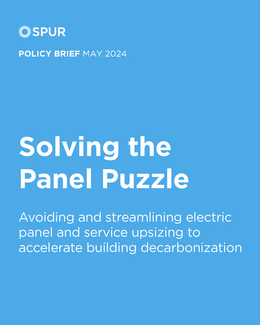Switching home energy uses from fossil fuels to electricity will improve air quality and meet state climate goals. But California’s plan to decarbonize its buildings faces significant challenges due to the complexities and costs of electric panel and service upgrades. Often the most expensive and time-consuming aspects of electrification, these upgrades discourage building owners from undertaking electrification projects, clog utilities’ work queues, and increase costs for ratepayers. To avoid the upgrades and streamline them when they are truly necessary, state and local authorities and electric utilities can promote panel optimization strategies, and authorities responsible for state and national electrical codes can make updates to support electrification.
SPUR suggests three strategies to overcome the building electrification barriers. First, electrify buildings without touching the electrical panel or service, thereby saving building owners money and time and allowing utilities to eliminate expensive upgrades to distribution infrastructure. Second, make unavoidable service upgrades as quick and affordable as possible, and pass policies to encourage building owners to undertake these upgrades at the least disruptive times. Third, improve the state’s understanding of the impact of electric panel and service upsizing for building owners, utilities, and electrical rates, and compile better data to support utility planning for distribution grid upgrades.
By adopting the 17 recommendations SPUR offers, California can facilitate the transition to a climate-friendly, climate-ready built environment and serve as a model for other states to achieve a sustainable, electrified future.
